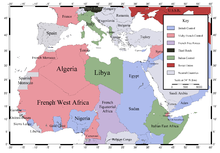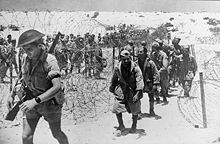World War II and the fall of Fascism
When Germany invaded Poland on 1 September 1939 beginning World War II, Mussolini choose to stay non-belligerant, although he declared his support for Hitler. In drawing out war plans, Mussolini and the Fascist regime decided that Italy would aim to annex large portions of Africa and the Middle East to be included in its colonial empire. Hesitance remained from the King and military commanderPietro Badoglio who warned Mussolini that Italy had too fewtanks, armoured vehicles, and aircraft available to be able to carry out a long-term war and Badoglio told Mussolini "It is suicide" for Italy to get involved in the European conflict.[93]Mussolini and the Fascist regime took the advice to a degree and waited as France was invaded by Germany before deciding to get involved.
As France collapsed under the German Blitzkrieg, Italy entered the war on 10 June 1940, fulfilling its obligations towards the Pact of Steel. Mussolini hoped to quickly capture Savoy, Nice, Corsica, and the African colonies of Tunisia and Algeria from the French, but Germany signed an armistice with MarshalPhilippe Pétain establishing Vichy France, that retained control over southern France and colonies. This decision angered the Fascist regime. In summer 1940, Mussolini ordered the invasion of Egypt, but Italian forces were soon driven back by the British. Hitler had to intervene with the sending of the Afrika Korps of General Erwin Rommel, that was the mainstay in the North African campaign.
Continuing indications of Italy's increasing subordinatation to Germany arose during the disastrous Greco-Italian War. Mussolini had intended the invasion of Greece to prove Italy strategic autonomy, but the Greeks humiliatingly put Italian forces on the defensive.[95] To gain back ground in Greece, Germany reluctantly began a Balkans Campaign which resulted also in the dissolution of the Kingdom of Yugoslavia and the ceding of Dalmatia to Italy. But despite territorial achievements, the Italian Empire was a paper tiger by 1942: it was faltering as its economy failed to adapt to the conditions of war, and Italian cities were being heavily bombed by the Allies. Also, despite Rommel's advances, the campaign in North Africa began to fail in late 1942. Complete collapse came with the decisive defeat at El Alamein.
By 1943, Italy was losing on every front. By January of the year, half of the Italian forces serving in Russia had been destroyed, the African campaign had failed, the Balkans remained unstable, and Italians wanted an end to the war. In July 1943, the Allies invaded Sicily in an effort to knock Italy out of the war and establish a foothold in Europe. On 25 July, Mussolini was ousted by the Great Council of Fascism and arrested by order of King Victor Emmanuel III, who appointed General Pietro Badoglio as new Prime Minister. Badoglio stripped away the final elements of Fascist rule by banning the Fascist Party, then signed an armistice with the Allied armed forces and the Kingdom of Italy joined the Allies in their war against Nazi Germany.
Civil War, Allied advance and Liberation
Soon after being ousted, Mussolini was rescued by a German commando inOperation Eiche ("Oak"). The Germans brought Mussolini to northern Italy where he set up a Fascist puppet state, the Italian Social Republic. Meanwhile, the Allies advanced in southern Italy. In September 1943, Naplesrose against the occupying German forces. The Allies organized some royalist Italian troops into the Italian Co-Belligerent Army, while troops loyal to Mussolini continued to fight alongside Nazi Germany in the Esercito Nazionale Repubblicano. In addition, a large Italian resistance movementstarted a long guerrilla war against the German and Fascist forces.
The Germans, often helped by Fascists, committed severalatrocities against Italian civilians in occupied zones, such as the Ardeatine massacre and the Sant'Anna di Stazzema massacre. On 4 June 1944, the German occupation of Rome came to an end as the Allies advanced. As the Allies advanced north, they encountered increasingly difficult terrain, as mountains offered excellent defensive position to Axis forces. The final Allied victory over the Axis in Italy did not come until the spring offensive of 1945, after Allied troops had breached the Gothic Line, leading to the surrender of German and Fascist forces in Italy on 2 May shortly before Germany finally surrendered ending World War II in Europe on 8 May. It is estimated that between September 1943 and April 1945 some 60,000 Allied and 50,000 German soldiers died in Italy.
Mussolini was captured on 27 April 1945, by communist Italian partisans near the Swiss border as he tried to escape Italy. On the next day, he was executed for high treason, as sentenced in absentia by a tribunal of theCLN. Afterwards, the bodies of Mussolini, his mistress, and about fifteen other Fascists were taken to Milanwhere they were displayed to the public. Days later on 2 May 1945, the German Army (Wehrmacht Heer) in Italy surrendered. The government of Badoglio had remained in being for some nine months. On 9 June 1944 he was replaced as Prime Minister by the 70-year-old anti-fascist leader Ivanoe Bonomi. In June 1945 Bonomi was in turn replaced by Ferruccio Parri, who in turn gave way to Alcide de Gasperi on 4 December 1945. Finally, De Gasperi supervised the transition to a Republic following the abdication of Vittorio Emanuele III on 9 May 1946, the one-month long reign of his son Umberto II and the Constitutional Referendum that abolished the monarchy; De Gasperi briefly became acting Head of State as well as Prime Minister on 18 June 1946, but ceded the former role to Provisional President Enrico de Nicola ten days later.



